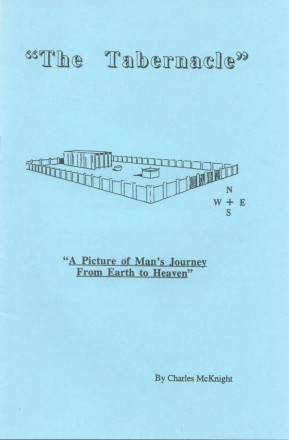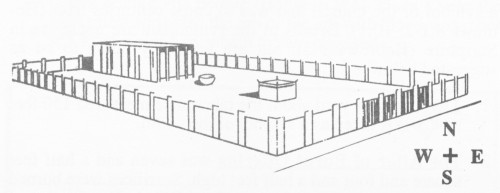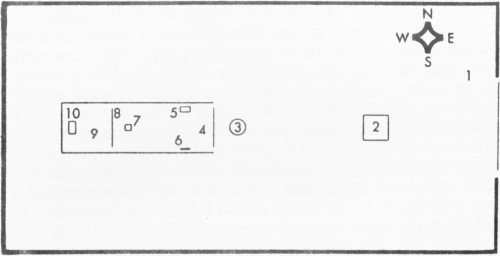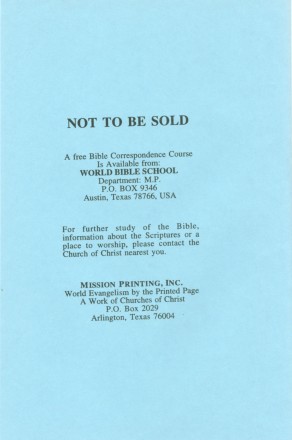

Front Cover

The People Encamped Around This Structure.
| East: | Issachar; Zebulun; Judah; Moses and Aaron and his priestly family. |
| North: | Asher; Dan; Naphtali; Merarites of the tribe of Levi. |
| West: | Manasseh; Ephraim; Benjamin; Gershonites of the tribe of Levi. |
| South: | Simeon; Reuben; Gad; Kohathites of the tribe of Levi. |
1
God gave Moses directions for building the tabernacle and warned him to follow the directions exactly (Exodus 25:9). No doubt one reason for such care was that the tabernacle was to be a symbol of the church that was to come centuries later (Hebrews 8:1–2; 10:1). Details of the symbolism are not given in Scripture (Hebrews 9:5), but are generally taken to be as suggested below.
The Court or yard about the tabernacle measured 150 feet by 75. It is taken as a symbol of the world.
The Altar of Burnt Offering was seven and a half feet square and four and a half feet high. Sacrifices were burned upon it, symbolizing the sacrifice of Christ for the sins of the world.
The Laver was a large basin where the priests washed their hands and feet before going into the Holy Place. It is a symbol of Christian baptism.
The Holy Place, 30 by 15 feet, symbolized the church separated from the world (the court) and entered by the way of Christ's sacrifice (the altar) and baptism (the laver).
The Table of Showbread, on which twelve loaves were placed every week, was a symbol of the Lord's Supper.
The Candlestick, more properly a lamp stand holding seven candles, gave light for the Holy Place. Thus, it was a symbol of God's Word, which enlightens the world.
The Altar of Incense provided a place where incense was burned. The sweet smelling smoke ascended like the prayers of God's people.
The Veil was a curtain between the Holy Place and the Most Holy Place. It symbolized the separation between heaven and the Christians on earth.
The Most Holy Place, a perfect cube 15 feet long, wide, and high, was a symbol of heaven, the particular place of God's presence.
2
The Ark of the Covenant was a wooden chest covered with gold and having a golden lid bearing two golden cherubim. The ark contained the Ten Commandments, symbolizing God's government, a dish of manna, recalling God's providence; and Aaron's rod, a reminder of God's power among His people (Hebrews 9:4). Once a year the high priest sprinkled the top of the ark with blood, a symbol of Christ's blood by which we are cleansed.

It was a Chinese Philosopher who once said, “A picture is worth a thousand words.” How true this is.
All of us have been told stories of older relatives such as grandmother or great-grandfather, etc. Fuzzy images were created in our minds of these people, but when we were shown a picture of these “old” people, the stories about them took on new meaning. My grandfather died in February, 1942. Five months before he died, he had his picture taken with his wife and their son. The son was dressed in his army uniform and was home on his last leave before going overseas. I was there when the picture was taken. Although 45 years have passed since then, I still retain in my memory vivid images of that day. I can still see the three of them positioning themselves before the camera, hear
3
the click of the little box, which captured forever the “still” forms of their vibrant lives, and watched and listened at they drew apart, laughing and talking about how the picture would turn out. As I look at this “still” picture today, I am assisted in bringing back through the midst of time the meaning of that long ago moment.
Through the magic of television, Sesame Street is a very popular children's program. Why? The answer to that lies in the fact that the subject matter is very graphically presented through “action scenes,” “pictures,” and “stories” which are easily retained in one's mind as mental images. For example, a couple of years ago I was watching Sesame Street for a moment when they were demonstrating what far and near meant. This little character ran up to the television camera so that his face covered my TV screen and yelled: “This is near!” Then he ran way back in the distance until he appeared as a little fly–speck on the bottom, right-hand corner of my TV screen and yelled at the top of his voice, “This is far!” After doing this two or three times, I finally got the message, and he quit. This little demonstration made a deep impression on my mind so that it is almost impossible to blot it out.
When children who watch this program begin attending school for the first time, usually in kindergarten, they are years ahead in their knowledge and understanding compared to me when I started school in 1939. Those involved in the production of Sesame Street realize the value of pictures in impressing mental images on the minds of impressionable folks. Those who produce TV commercials employ the same technique to market their products. But this is not a new approach to teaching. God employed this same procedure. What are the miracles recorded in the Gospels? Pictures of God's amazing grace; glimpses of the character of God! Is the tabernacle constructed by Moses a picture of anything?
The Court:
This is described in Exodus 27:9–19; 35:17–18. The tent inside the court, housing the Holy Place and Holy of Holies, was surrounded by a “fence–like” curtain made of white linen. This
4
court was 150 feet long by 75 wide and 7 1/2 feet high. Its entrance was 30 feet wide. Encamped around this structure were the Israelites as outline in Numbers 2–3. The contents within this court consisted of three main objects:
The Tabernacle:
In arrangement it was intended to illustrate the three states of man: natural man, as represented by the court; grace, as seen in the Holy Place; and glory, as illustrated by the Most Holy Place, that is, Holy of Holies.
It had two rooms:
When we open the Old Testament and begin reading in the Book of Genesis, we soon discover that no house of prayer existed on earth from the time of Adam to Moses.
Three institutions arose out of God's Word:
5
6
In conclusion, then, we find that spiritual worship is the only worship acceptable to God. Since God is a Spirit, He has created out of mankind a spiritual temple in which man may offer up spiritual sacrifices and engage in spiritual worship. Since a man cannot sing separate and apart from his body, he is commanded to present himself to God at the place and time appointed by God to “offer up spiritual sacrifices, which is your spiritual service”(Hebrews 10:24–25; Acts 20:7; I Peter 2:5; Romans 12:1). No man could have dreamed up this beautiful piece of architecture for no man could have envisaged its spiritual significance without divine revelation. That is why the writer of the book of Hebrews tells us that the tabernacle was a copy “of the things in the heavens,” “the copy and shadow of the heavenly things” (Hebrews 9:13; 8:5). For the tabernacle that Moses was commanded to build was not a copy of anything existing on earth. In order to have a proper grasp of the nature of
7
God's spiritual temple in the Christian age it is necessary to understand the significance of the tabernacle.
Man Needs Divine Instruction:
Since man is a sinner (Romans 3:23), and sin separates man and God (Isaiah 59:2), there is the need for revelation, for revelation restores. In dealing with man's moral and spiritual bankruptcy, God's first act of recovery was information (Genesis 3:15). In divine revelation God presents to man in clear and definite terms His offer to restore the relationship between Himself and man—a relationship which has been broken by sin. To that end the call to the sinner reads, “Incline your ear, and come to Me. Hear, and your soul shall live” (Isaiah 55:3. Compare John 5:25). From this it is clear that the process of man's salvation is not an effort to adjust God to man, but man to God.
God's Several Methods's of Teaching:
8
Paul speaks of the age of the types as “the dispensation of the mystery” which was finally “made known by the church” (Ephesians 3:9–11). In this respect the divine type was like the printer's type. While smeared with the black ink, it does not appear to contain much information; but when the impression, or the antitype, is made, it becomes the intellectual light of the world. Likewise our spiritual light has come out that which was once a dark mystery. When Jesus, the antitype, came, He said, “I am the light of the world” (John 8:12).
The Court:
This enclosure was a type of the world where Christ is preached. Revelation 11:2 reads: “But leave out the court which is outside the temple, and do not measure it, for it has been give to the Gentiles [nations].” We see by this verse that this court is occupied by “the nations” or the world to whom the Gospel is proclaimed (Mark 16:15).
The idea is set forth in picture form by all the Israelites being allowed into this court, but they did so as sinners with sacrifice asking for mercy. The twelve tribes positioned around the tabernacle represented the twelve nations, for God said to Abraham, “... and you shall be a father of many nations” (Genesis 17:4). He was also the father of the Ishmaelites, the Midianites, the Edomites, and their kings (Genesis 17:20; Genesis 36; Matthew 1). Each man enters this state, that is, this court, by fleshly birth and when he becomes accountable is dealt with as a sinner.
9
The Altar:
Just inside the entrance to the court stood the altar of burnt offerings (Exodus 27:1–8). This was a public altar upon which one lamb was offered in the morning and one in the evening (Exodus 29:38–39). The fire upon it was never to go out (Leviticus 6:12–13).
The New Testament tells us that “We have an altar,” who is Jesus (Hebrews 13:10–12). The word altar is used as a metonymy for Christ Himself. The word metonymy is “a figure of speech consisting of the use of the name of one thing for that of another of which it is an attribute.” In reference to the sacrifices of the Old Testament, Paul reasons, “Observe Israel after the flesh: Are not those who eat of the sacrifices partakers of the altar” (I Corinthians 10:18)?
And again Paul reasons, “Do you not know that those who minister the holy things eat of the things of the temple, and those who serve at the altar partake of the offerings of the altar” (I Corinthians 9:13). To eat of the altar is to eat of the sacrifice which is offered on the altar. And that the sacrifice in this case was the sacrifice of Christ is evident from the context from which the above passages were taken, as well as from other parallel passages. (See John 6:53–55, 63).
In the Jewish system, the Israelites ate the physical flesh of the physical lamb, but today we eat of the sacrifice of Christ through faith (John 6:47; 20:31; Acts 16:31). As this typical altar was seen through the veil covering the entrance, so we Christ crucified through the four gospels.
And just as all men could come to this typical altar for atonement, so all men can now come to Christ for cleansing from sin (John 8:24; 12:32; I John 2:2).
The Laver:
This is mentioned in Exodus 30:17–21; 38:8; 40:7 and stood between the altar and the tent of the congregation. The priests were to bathe in this at the time they were consecrated to their office (Exodus 29:4). This they must do before they entered the tent or officiated in the altar of burnt offerings. Failure to do this
10
was punishable by death (Exodus 30:17–21). We need to keep in mind that the common Jew could not go beyond the altar of burn offerings, but was represented by the priest. The laver had for its counterpart Christian baptism. We can see this in the following:
In design, the tabernacle pictures the wonderful story of the church on earth and her relation to heaven.
The first room was 45 feet by 15 feet by 15 feet and was a type of the church where Christ is worshiped. When you look at the
11
pictures of the tabernacle at the beginning of this book, you will see that this first room containing three articles refers to things beyond the outer court where in type one becomes a Christian.
Paul says in Hebrews 9:2, 6: “For a tabernacle was prepared: the first part, in which was the lampstand, the table, and the showbread, which is called the sanctuary.
“Now when these things had been thus prepared, the priests always went into the first part of the tabernacle, performing the services.” Peter says that all that are in the church are priests (I Peter 2:5, 9). So we can see by this that the first room of the tabernacle was typical of the church and its services of Christian worship.
The Door Into The Holy Place (Exodus 26:36–37):
It consisted of a veil of fine linen embroidered in blue, purple, and scarlet, and hung on five golden pillars set in sockets of brass. The door in to the Holy Place is a type of the new birth which is the way one enters into God's kingdom which is His “body, the church” (John 3:3; Matthew 16:18–19; Ephesians 1:22–23; Colossians 1:18).
Looking back we see that the priest had to do two things before they could enter through this door into the Holy Place. They had to offer a sacrifice on the altar of burnt offerings and wash at the laver. The journey the priest made from the altar to the entering in of the Holy Place is set forth in the New Testament.
Christ, our altar, is preached, men hear the message, repent of their sins, confess Him before men, and are immersed into His name. (See Acts 2:14, 36–38; Romans 10:9.) When these obligations have been attended to, people are added to the church of Christ (Acts 2:47).
The five pillars on which the veil was hung suggests the four Gospels and the book of Acts, for the information in these books is necessary to make one a Christian.
The facts in the first four enable one to believe in Christ (John 20:30–31). while the book of Acts informs one how to be saved from his past sins (Acts 2:38; 8:12, 26–40; 16:30–33; 22:16).
12
The Table of Showbread (Leviticus 24:5–9, Exodus 25:23–30):
In Hebrew, showbread means “presence–bread” because it stood before Jehovah. It was renewed every Sabbath (Leviticus 24:8) and was eaten by Aaron and his sons (Leviticus 24:9) while the incense was burned unto Jehovah. As in the tabernacle, so in the church, there is the table of the Lord. In each case certain important matters appear:
The Lampstand (Exodus 25:31–39, 37:17–24:
Concerning the typical meaning of the lampstand, we are left in no doubt. It was a type of the Word of God (Psalm 119:105) and, as such, it teaches some very important truths.
13
The Altar of Incense (Exodus 30:1–10):
Every morning and evening highly perfumed incense was burned upon the altar. In both the Old and New Testaments, incense is spoken of as a type of prayer (Psalm 141:2; Luke 1:9–10; Revelation 5:8; 8:3–4). The altar of incense presents some very definite teaching concerning prayer.
14
This room was a type of heaven where Christ is seen. Such is the meaning given it by inspiration. Paul, in his description of the tabernacle, tells us that as the Jewish high priest entered into “the second part” of the tabernacle once a year with atonement blood, so Christ, “... with His own blood He entered the Most Holy Place once for all ...now to appear in the presence of God for us” (Hebrews 9:7, 11–12, 24). In John's vision of heaven he saw the great blood–washed multitude with “... the Lamb who is in the midst of the throne will shepherd them and lead them” (Revelation 7:13–17).
15
The Veil (Exodus 26:31–32):
The division between the rooms reached from wall to wall and is spoken of as “the second veil” (Hebrews 9:3). This beautiful curtain was hung on four golden pillars set in sockets of silver. As the way into the Holy Place, the veil was typical of the sacrificed body of Christ, called “a new and living way” by which we enter the heavenly Holy Place (Hebrews 10:19–20).
Before the Savior's death, the way to heaven was closed, a fact proclaimed by the typical veil (Hebrews 9:8), but when he expired on the cross, “the veil of the temple was torn in two from top to bottom” (Matthew 27:51). This act of God signified that the way to heaven was opened by the death of His Son. The four pillars in which the veil was suspended might have been typical of the four divisions of the New Testament—the Gospels, Acts, Epistles, and Revelation—for all are needed in order to obtain an “entrance ... into the everlasting kingdom” (II Peter 1:11).
The Ark (Exodus 25:10–22):
Finally, we have reached the guidance chamber of the King where He spoke to His people. Here we find one piece of furniture, the Ark. It was chest–like in design and measured 2 1/2 cubits long, by 1 1/2 cubits wide, by 1 1/2 cubits high. It was made of acacia wood and overlaid with gold inside and out. Around the top it had an ornamental crown of gold. Its legs had four rings in which staves were fastened for transportation. For a cover it had a slab of pure gold called “the mercy–seat,” on top of which were two golden cherubim facing each other with outspread wings. Within the ark were “the golden pot that had the manna, Aaron's rod that budded, and the tablets of the covenant” (Hebrews 9:4). The only light for this room was the glory of Jehovah. The spiritual significance of the ark is seen in its design. The fact that it contained divine law, or government, and was the place of Deity's manifestation leads to the conclusion that it was intended as a type of the throne of God.
This meaning is in harmony with the room itself, which was a miniature heaven on earth. It is also established by John's vision at heaven's door, for he saw “a throne set in heaven, and One sat on the throne” (Revelation 4:2).
16
The cherubim represented the heavenly messengers who are interested in and employed with reference to man's salvation (I Peter 1:12). Isaiah saw them (Isaiah 6:1–3), and so did John (Revelation 5:11).
The mercy–seat was a type of Christ. The Hebrew term for mercy-seat, kapporeth, is equal to the Greek word, hilasterion, rendered propitiation in I John 2:2; 4:10, and means a covering; hence Jesus is called the covering for our sins. As the mercy–seat was sprinkled with blood on the Day of Atonement (Leviticus 16:14–15), so Christ “who God set forth to be a propitiation [covering] by His blood, through faith” (Romans 3:25).
The arrangement of the type is revealing. Within the ark were “the tablets of the testimony” witnessing against man, because he had broken the law of Jehovah. But the mercy–seat was between the law and the sinner, which signified that divine mercy intervenes between the two. Therefore, Paul could say to God, in speaking of His kindness, that “according to His mercy He saved us” (Titus 3:4–5).
The tables of the covenant within, with the Book of the Law by the side (Deuteronomy 31:26), indicated that the throne of God is the seat of revelation and final authority in religion.
The pot of manna was a memorial of divine supply for bread for Israel in their journey from Egypt to Canaan (Exodus 16:33–34), and it points to the fact that Jehovah is the material and spiritual support of His people. Aaron's rod that budded (Numbers 16–17) symbolized divinely appointed leadership among Jehovah's people.
The lesson is that in the official ministry of revealed religion “no man takes this honor to himself” (Hebrews 5:4). As Jehovah designated the ministry in the type, so His Son has named the offices and made known the personal qualifications of His servants in the church.
17
The Jewish tabernacle represents a pictorial summary of man's journey from earth to heaven (Exodus 25:40; Hebrews 8:5). In the outer court, or the world, he is seen as a sinner “having no hope and without God” (Ephesians 2:12). It is here, in this outer court, the the Redeemer is preached, believed, and obeyed, and the man far from God is “made near by the blood of Christ” (Ephesians 2:13). In the first room of the tent, typical of the church, the sinner's condition is changed. He has “passed from death to life” (I John 3:14). He is no longer an alien, but a member “of the household of God” (Ephesians 2:19), where he may sit at the divine table, have access to the throne of grace, and live in the light of God's Word. The second room of the tabernacle, the throne room of the King and a picture of heaven, is a prophecy of man's eternal destiny. Since this Most Holy Place was entered through the first apartment, the arrangement was meant to signify that the way to heaven is through the church of Christ.
There Is A Habitation
(Hebrews 12:22–24)
There is a habitation
Built by the living God,
For all of every nation,
Who see that grand abode.
18

Back Cover